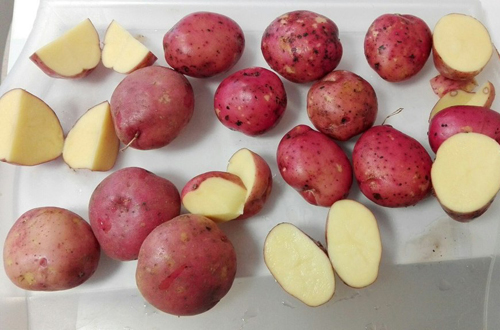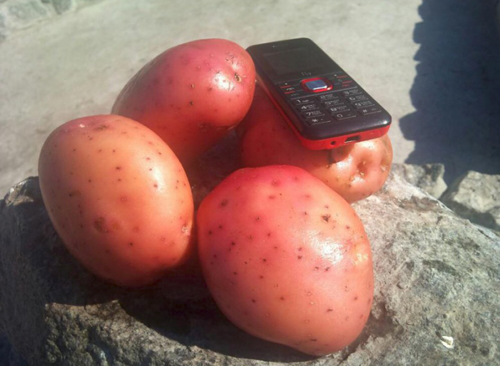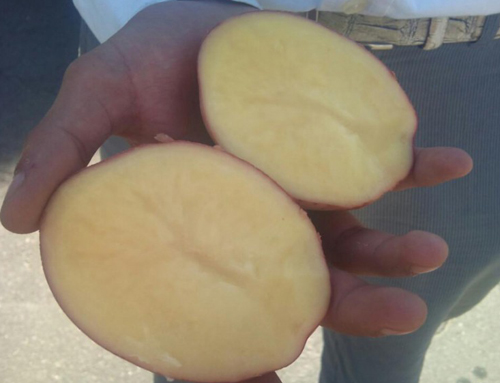Arosa potato variety
Arosa is a German potato variety (Solanum tuberosum) with an ultra-early ripening period. Bred by employees of the company "Solana GmbH & CO KG" in the late 90s. It was included in the state register of plants of the Russian Federation in 2000. Approved for cultivation in five regions of the country: North Caucasian, Middle Volga, Ural, West Siberian, East Siberian. It has a universal purpose, is distinguished by drought resistance and stable high yield. Suitable for mechanical cleaning and long-term storage.

The time from the emergence of full shoots to harvest is 60-65 days. The first digging can be done on the 45th day of the growing season.
The plant is semi-erect, moderately spreading, with an abundant amount of green mass. Potato leaves are medium or large, dark green in color, sometimes lighter. A noticeable waviness is observed along the edges of the sheet plate. The flowers are red-violet in color, collected in corollas of medium size.
Up to 15 tubers weighing 71-135 grams are formed on one plant. Arosa tubers are oval in shape, slightly flattened. The rind is thin, but firm, red in color. The flesh on the cut is yellow, does not darken during heat treatment. The depth of the eyes is average.
The marketable yield, according to the results of state tests, is 188-204 c / ha, 65-111 c / ha more than the indicators of the Pushkinets variety. On the 45th day of the growing season (first digging) in the Republic of Mordovia, 126 c / ha were harvested, 38 c / ha higher than the standard, and on the 55th day (second digging) - 208 c / ha, which is 61 c / ha more than normal. The maximum yield was also recorded in Mordovia - 248 c / ha, 94 c / ha higher than the established standards. According to some reports, the potential indicator that can be achieved reaches 500 c / ha, but there is no confirmation of such results in official sources. The marketability of tubers is 77−97%, keeping quality is very good - 95%.

The taste is excellent. Arosa is classified as culinary type B (according to the EAPR - European Association for Potato Research). The pulp is medium-sized, not watery. Tubers have a universal purpose in cooking, but they are best suited for frying, baking, stuffing, and will also be an excellent addition to salads, soups and vegetable mixtures. But this variety is especially popular in the preparation of French fries and chips. Actually, the originator himself in his description indicates that he is ideal for deep-fried frying! The tubers contain about 12.2-14.3% starch.
Plants adapt well to any type of soil and different climatic conditions. Due to its drought tolerance, this potato is very popular in the southern regions of the country. Gardeners note the stability of the crop, which does not depend much on weather conditions. Plants do not require special attention to themselves, but they respond perfectly to an increased amount of applied mineral fertilizers. As for watering, in northern areas with cool summers, it may not be required at all. And this is definitely a plus, because Arosa can be grown on an industrial scale without using artificial irrigation installations! Of course, in the southern regions, it is still necessary to monitor soil moisture - excessive drying out of the soil will painfully affect plantings.
During the growing season, it is advisable to feed the plants once or twice. Approximate rates of fertilization are calculated based on the characteristics of the nutrient and mineral composition of the soil. Do not forget also about the standard agricultural techniques - loosening and hilling, weeding, preventive treatment against diseases and pests. Another advice that experts give is to mow the tops 2-3 weeks before harvesting. This is done in order to prevent late blight.

Arosa is resistant to diseases such as cancer, golden cyst nematode, wrinkled and banded mosaic, moderately resistant to leaf roll virus. According to the originator, it has a moderate susceptibility to the causative agent of late blight.However, among such an extensive list of invulnerability, one caveat stands out - it is strongly recommended to treat plants against Rhizoctonia and silver scab. According to the observations of gardeners, the Colorado potato beetle is very fond of the tops of this variety, but with proper and timely prevention, this will not become a serious problem.
Potato growers in various regions of the country speak very well of this variety. Among all its advantages, drought resistance and undemandingness to soils are especially distinguished, due to which Arosa has a very wide distribution area in Russia. Also, gardeners note the stability of yield, which is kept at a high level even in bad weather conditions. And not only during heat and drought, but also during cool summers with a lot of precipitation! A huge plus is the low tendency to degeneration, due to which the seed does not need to be frequently renewed.
Of course, excellent taste is also included in the list of the main advantages of the variety, and its suitability for deep-frying and industrial production of chips is especially appreciated. It should be noted that the keeping quality is very good, the tubers can be stored until the spring of next year without losing their presentation, they are not prone to germination. It is also necessary to mention the resistance of tubers to mechanical damage, making them suitable for machine harvesting. At the same time, they are quite even, the peel, although strong, is thin, which facilitates the process of cleaning the tubers. Gardeners also like the uniformity of tubers in size - the amount of small items in one nest is minimal.
As for the shortcomings of the variety, they were not found. Maybe Arosa does not have an ultra-high yield, but its reliability compensates for this. With minimal maintenance and even an unsuccessful summer, you will not be left without potatoes!








